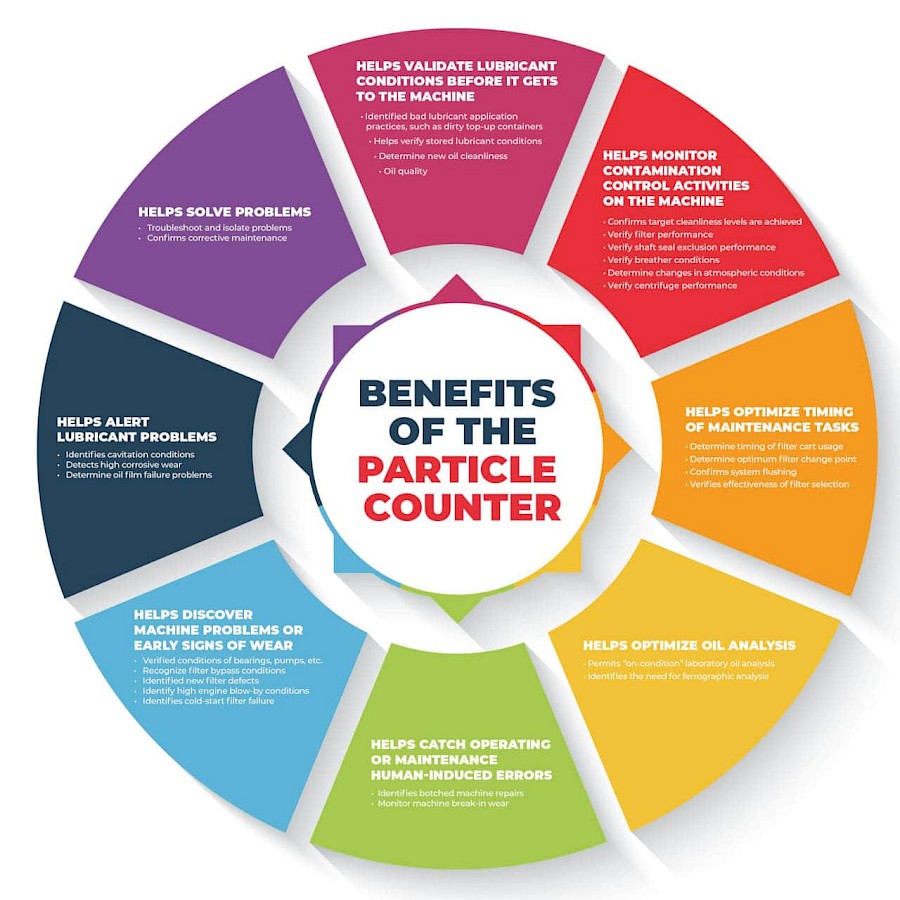Preventing Equipment Failure, One Particle at a Time
 Extending the Life of Your Equipment Through Particle Counts
Extending the Life of Your Equipment Through Particle Counts
These are the words of an unnamed supervisor of a lubrication technician in my recent Oil Analysis Level II course. This technician knew that couldn’t be right — as did I and just about everyone else in my class. It’s a bit perplexing to hear a statement like that. How could he possibly think that? By the end of the week, not only was there a clear understanding of the importance of particle counts, but a very strong understanding as to why it might be the most important aspect in preventing equipment failure.
To understand this, let’s start with why. Why do we analyse wear debris? Why do we analyse particle contamination?
Wear debris is a crucial early sign of machine failure. It’s like a lit fuse to a catastrophic event, especially for critical machines. Most condition monitoring technologies and predictive maintenance strategies focus on discovering the signs of failure as soon as possible. After all, wear debris is a direct result of metal being removed from surfaces, usually from frictional interactions. The severity and urgency of wear debris issues should not be underestimated, and if discovered quickly and acted upon correctly, the progression of failure can be slowed down or delayed.
But why did the failure occur in the first place? What is the match that lit the fuse? While there could be many culprits, contamination is well-documented by machine OEMs and user group studies as the most common root cause of machine failure. And of the forms of contamination responsible for machine failure, particle contamination is the most common. Thus, monitoring and controlling contamination in machines is how we prevent equipment failure — even before it begins. How is this possible? By tracking particle counts on oil analysis.
Here are some of the reasons why tracking particle counts bring you benefits across the lifecycle of the lubricant, the lifecycle of the machine, and the many maintenance activities in between:
1. Particle counts help validate a lubricant’s conditions before it’s even in the machine
When lubricants are purchased, their cleanliness must be determined. Unfortunately, new oil does not always mean clean oil. New oil cleanliness is critical, not just for avoiding particle-induced wear in the machine, but also for avoiding damage to the lubricant during periods in storage containers. Particles can strip additives and promote oxidation. And if lubricants are transferred to the machines using dirty transfer equipment or dirty top-up containers, this will be picked up quickly with particle counts as well.
2. Particle counts help monitor the contamination control objectives on the machine
Firstly, particle counts are great for trending and confirming target cleanliness levels over time, allowing for the detection of compromises in contamination exclusion practices, which can include a loss in the performance of shaft seals, headspace breathers and cylinder wiper seals. Similarly, particle counts can also monitor contamination removal effectiveness, such as impaired filter or centrifuge performance. The exclusion and removal practices must always be kept in balance for optimal proactive maintenance.
3. Particle counts help optimize the timing and urgency of maintenance activities
Simply knowing when to change a filter can be indicated by particle counts — often sooner than the differential pressure gauge on the filter. But similarly, if machine conditions change (including atmospheric contamination levels), particle counts can be validation that the filter choice is appropriate for the application. And for machines that do not have permanently installed filtration systems, particle counts can help determine the timing of filter cart usage.
4. Particle counts help optimize oil analysis activities
Monitoring for particle contamination is established as a routine oil analysis test for nearly all machines on oil analysis. High particle counts are simply a sign of an issue and a trigger for the technician to investigate the cause, which involves the analysis of data across several oil analysis tests, including the addition of exception tests. For example, analytical ferrography is too costly and unnecessary to perform routinely, but a series of rising particle counts, or one abnormal spike, can be the justification for such tests.
5. Particle counts help catch operating or maintenance human-induced errors
If repair work was performed or machines were recently installed with new parts, particle counts can monitor for botched work. This may include debris from machining or welding or airborne contaminants that entered the machine while work was being performed that were not properly filtered out before start-up. Particle counts can also monitor for abnormal break-in wear.
6. Particle counts help discover machine issues or early signs of machine wear
Monitoring the overall health of machine components such as pumps, bearings and gears can be linked directly to the trends of particle counts. This includes monitoring for contamination intrusion and wear debris. But similarly, particle counts will watch ancillary components for issues that can lead to collateral damage to the primary components, like ruptured filters, unexpected filter bypass, or other filter failures from unusual operating conditions, such as cold-start conditions.
7. Particle counts help alert to lubricant issues
Various types of wear can occur when lubricants are not selected correctly or aren’t performing as expected. Improper viscosity selection, additive depletion or impaired performance from other contaminants (such as air and water) can lead to cavitation wear, corrosive wear or oil film failure. This can be indicated by rising particle counts.
8. Particle counts help troubleshoot and solve problems
After problems are discovered, whether its high contamination, abnormal wear or even lubricant failure, particle counts can be a tool in the troubleshooting process. For example, analyzing the results of the particle counts after testing at different points in a circulating system can be a quick indicator of where the ingression source or wear generation source is located. Even after corrective actions are in place, the ongoing monitoring of particle counts can validate that the solution was successful.

The Right Test Slate
Particle counters have a multitude of uses and, when used correctly, can greatly improve equipment reliability. Considering that the particles being monitored by the trending data from a particle counter include both contamination (which causes wear) and wear debris (the effect of wear), the particle counts can be both a leading indicator and a lagging indicator of machine failure.
Where many fall short in reaching the real opportunity of particle counts is connecting the dots between cause and effect. Take, for example, monitoring for wear metals with elemental analysis or ferrous density: These are critical indicators for machine failure and must be on most oil analysis test slates. But if one is only looking for wear debris by itself, then the damage is already in progress and may be too far developed to correct the problem without shutting the machine down.
Particle counting isn’t perfect. It’s only looking at the concentration of particles at different specific sizes, with 4 microns as the smallest reported size. Thus, there are shortcomings when trying to identify contaminant type or monitor for contaminants at smaller micron sizes, which are both very important in oil analysis. Also, interference challenges can exist with certain types of particle counters, and even sampling practices can play a large role in creating false positives or false negatives. All of this can be remedied with the right awareness, training and implementation of best practices.
Particle counting alone isn’t the answer to preventing failure, but it is an essential element in nearly all oil analysis test slates. The value is even greater when considering a particle counter as an onsite oil analysis instrument to allow for more frequent and immediate answers to particle contamination concerns. Staying focused on the root cause is the theme behind effective proactive maintenance. This includes establishing optimum cleanliness targets, taking specific action to control contamination, and measuring contaminant levels frequently. This cannot be accomplished without vigilant practices using particle counts.
